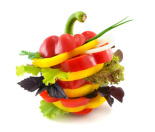Several years ago I watched a program on TV showing the cross contamination of handling meat in the kitchen. They showed two or three cooks making a meal and then cleaning up the kitchen. Then they showed the kitchen with an infrared light which showed the spread of bacteria and germs that were left behind.
The kitchen looked like this green image:
This program made me think, big time. If you can’t see germs, what’s the big deal right? It left a lasting impression in my mind. If I was going to handle raw meat, wash it and cut it up and marinate it, I was going to be extra diligent to wash everything I touched. I have to admit I became a bit OCD in my cleaning of the kitchen. I would watch chefs on TV use the same dishtowel to wipe their hands without washing their hands, and using knives that were not properly cleaned. It made me realize that the potential for germ exposure could be very high.
According to the CDC “ Each year, roughly 1 in 6 people in the US gets sick from eating contaminated food. The 1,000 or more reported outbreaks that happen each year reveal familiar culprits—Salmonella and other common germs. We know that reducing contamination works. During the past 15 years, a dangerous type of E. coli infection, responsible for the recall of millions of pounds of ground beef, has been cut almost in half. Yet during that same time, Salmonella infection, which causes more hospitalizations and deaths than any other type of germ found in food and $365 million in direct medical costs annually, has not declined. Each year, 1 million people get sick from eating food contaminated with Salmonella.”
Knowing that a million people a year get sick from eating food contaminated with Salmonella was enough for me to make some changes. I intuitively knew handling raw meat was a messy business that I no longer wanted any part of so I decided to go vegetarian. I realize that bacterias can be found in produce too, but I feel a lot more confident washing my fruits and vegetables. I use a product called Biokleen which is made out of grapefruit seed and lime peel extracts. It really does a nice job cleaning the wax and dirt off fruits and vegetables.
When using sponges or dishrags in the kitchen, it is important to wash them thoroughly so you don’t spread germs around your kitchen. That was the way the TV program showed how easily it is to spread germs with a contaminated sponge or dishrag. To kill germs it is recommended to microwave a sponge for 30 seconds, and toss your dishrags into a hot load of laundry daily. Paper towels work well too.
With a high number of people getting sick each year from foodborne illnesses, it might be a good time to set some new practices in the kitchen. Just another good reason to consider the benefits of a plant-based diet.
http://www.cdc.gov/vitalsigns/FoodSafety/index.html


